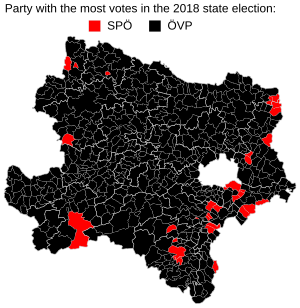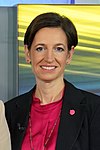2018 Lower Austrian state election
| |||||||||||||||||||||||||||||||||||||||||||||||||||||||||||||||||||||||||||
All 56 seats in the Landtag of Lower Austria 29 seats needed for a majority All 9 seats in the state government | |||||||||||||||||||||||||||||||||||||||||||||||||||||||||||||||||||||||||||
|---|---|---|---|---|---|---|---|---|---|---|---|---|---|---|---|---|---|---|---|---|---|---|---|---|---|---|---|---|---|---|---|---|---|---|---|---|---|---|---|---|---|---|---|---|---|---|---|---|---|---|---|---|---|---|---|---|---|---|---|---|---|---|---|---|---|---|---|---|---|---|---|---|---|---|---|
| Turnout | 922,807 (66.6%) | ||||||||||||||||||||||||||||||||||||||||||||||||||||||||||||||||||||||||||
| |||||||||||||||||||||||||||||||||||||||||||||||||||||||||||||||||||||||||||
 Results by municipality. | |||||||||||||||||||||||||||||||||||||||||||||||||||||||||||||||||||||||||||
| |||||||||||||||||||||||||||||||||||||||||||||||||||||||||||||||||||||||||||
The 2018 Lower Austrian state election was held on 28 January 2018 to elect the members of the Landtag of Lower Austria.
The ruling Austrian People's Party (ÖVP) fell just short of an absolute majority of votes, but retained its majority in the Landtag. Nonetheless, this was its worst result in the state since 1998. The Social Democratic Party of Austria (SPÖ) and Freedom Party of Austria (FPÖ) made gains, with the latter doubling its share of seats. The Greens took minor losses, while NEOS – The New Austria (NEOS) contested its first state election in Lower Austria, debuting at 5.2%. Team Stronach, which had won 9.8% in the previous election, did not compete.[1]
Background
The Lower Austrian constitution mandates that cabinet positions in the state government (state councillors, German: Landesräten) be allocated between parties proportionally in accordance with the share of votes won by each; this is known as Proporz. As such, the government is a perpetual coalition of all parties that qualify for at least one state councillor. After the 2013 election, the ÖVP had six councillors, the SPÖ two, and Team Stronach one.
Electoral system
The 56 seats of the Landtag of Lower Austria are elected via open list proportional representation in a two-step process. The seats are distributed between twenty multi-member constituencies. For parties to receive any representation in the Landtag, they must either win at least one seat in a constituency directly, or clear a 4 percent state-wide electoral threshold. Seats are distributed in constituencies according to the Hare quota, with any remaining seats allocated using the D'Hondt method at the state level, to ensure overall proportionality between a party's vote share and its share of seats.[2]
Contesting parties
The table below lists parties represented in the previous Landtag.
| Name | Ideology | Leader | 2013 result | ||||
|---|---|---|---|---|---|---|---|
| Votes (%) | Seats | Councillors | |||||
| ÖVP | Austrian People's Party Österreichische Volkspartei |
Christian democracy | Johanna Mikl-Leitner | 50.8% | 30 / 56 |
6 / 9 | |
| SPÖ | Social Democratic Party of Austria Sozialdemokratische Partei Österreichs |
Social democracy | Franz Schnabl | 21.6% | 13 / 56 |
2 / 9 | |
| FPÖ | Freedom Party of Austria Freiheitliche Partei Österreichs |
Right-wing populism Euroscepticism |
Udo Landbauer | 8.2% | 4 / 56 | ||
| GRÜNE | The Greens – The Green Alternative Die Grünen – Die Grüne Alternative |
Green politics | Helga Krismer | 8.1% | 4 / 56 | ||
Team Stronach, which contested the previous election and won 9.8% of votes, five seats, and one state councillor, did not contest the 2018 election.
In addition to the parties already represented in the Landtag, four parties collected enough signatures to be placed on the ballot.[3]
- NEOS – The New Austria (NEOS)
- Christian Party of Austria (CPÖ) – on the ballot only in Amstetten, Melk, and Mödling
- We for Lower Austria (WFNOE) – on the ballot only in Baden
Opinion polling
| Polling firm | Fieldwork date | Sample size |
ÖVP | SPÖ | FPÖ | Grüne | NEOS | Others | Lead |
|---|---|---|---|---|---|---|---|---|---|
| 2018 state election | 28 Jan 2018 | – | 49.6 | 23.9 | 14.8 | 6.4 | 5.2 | 0.1 | 25.7 |
| Research Affairs | 16–18 Jan 2018 | 413 | 45 | 23 | 21 | 5 | 5 | 1 | 22 |
| OGM | 8–16 Jan 2018 | 831 | 45 | 26 | 19 | 5 | 5 | – | 19 |
| Public Opinion Strategies | 2–11 Jan 2018 | 805 | 48 | 23 | 17 | 5 | 6 | 1 | 25 |
| Market | January 2018 | ? | 46 | 24 | 17 | 5 | 6 | 2 | 22 |
| Unique Research | 2–10 Jan 2018 | 500 | 47 | 23 | 18 | 5 | 5 | 2 | 24 |
| Research Affairs | 3–5 Jan 2018 | 410 | 45 | 22 | 21 | 4 | 5 | 3 | 23 |
| SOZAB | 30 Oct–25 Nov 2017 | 1,500 | 50 | 22 | 16 | 5 | 4 | 3 | 28 |
| OGM | 9–14 Nov 2017 | 784 | 45 | 25 | 20 | 4 | 4 | 2 | 20 |
| 2013 state election | 3 Mar 2013 | – | 50.8 | 21.6 | 8.2 | 8.1 | – | 11.3[a] | 29.2 |
Results

| ||||||||
| Party | Votes | % | +/− | Seats | +/− | Coun. | +/− | |
|---|---|---|---|---|---|---|---|---|
| Austrian People's Party (ÖVP) | 450,812 | 49.63 | –1.16 | 29 | –1 | 6 | ±0 | |
| Social Democratic Party of Austria (SPÖ) | 217,289 | 23.92 | +2.35 | 13 | ±0 | 2 | ±0 | |
| Freedom Party of Austria (FPÖ) | 134,085 | 14.76 | +6.55 | 8 | +4 | 1 | +1 | |
| The Greens – The Green Alternative (GRÜNE) | 58,401 | 6.43 | –1.63 | 3 | –1 | 0 | ±0 | |
| NEOS – The New Austria (NEOS) | 46,801 | 5.15 | +5.15 | 3 | +3 | 0 | New | |
| Christian Party of Austria (CPÖ) | 584 | 0.06 | –0.03 | 0 | ±0 | 0 | ±0 | |
| We for Lower Austria (WFNOE) | 367 | 0.04 | New | 0 | New | 0 | New | |
| Invalid/blank votes | 14,468 | – | – | – | – | – | – | |
| Total | 922,807 | 100 | – | 56 | 0 | 9 | 0 | |
| Registered voters/turnout | 1,386,356 | 66.56 | –4.31 | – | – | – | – | |
| Source: Lower Austrian Government | ||||||||
Results by constituency
| Constituency | ÖVP | SPÖ | FPÖ | Grüne | NEOS | Others | Total seats |
Turnout | |||||
|---|---|---|---|---|---|---|---|---|---|---|---|---|---|
| % | S | % | S | % | S | % | S | % | S | % | |||
| Amstetten | 52.7 | 2 | 23.0 | 1 | 13.8 | 5.5 | 4.6 | 0.4 | 3 | 69.4 | |||
| Baden | 40.1 | 2 | 29.0 | 1 | 15.9 | 7.8 | 6.6 | 0.5 | 3 | 61.5 | |||
| Bruck an der Leitha | 41.7 | 1 | 30.3 | 1 | 17.0 | 6.3 | 4.7 | 2 | 60.7 | ||||
| Gänserndorf | 46.4 | 1 | 28.2 | 16.5 | 5.3 | 3.6 | 1 | 62.5 | |||||
| Gmünd | 53.9 | 26.1 | 13.3 | 3.5 | 3.2 | 0 | 69.5 | ||||||
| Hollabrunn | 58.1 | 1 | 19.7 | 13.2 | 5.4 | 3.6 | 1 | 70.4 | |||||
| Horn | 65.0 | 15.8 | 11.7 | 4.1 | 3.4 | 0 | 72.7 | ||||||
| Korneuburg | 49.4 | 1 | 22.7 | 13.3 | 8.2 | 6.4 | 1 | 65.0 | |||||
| Krems an der Donau | 54.0 | 1 | 20.2 | 14.1 | 6.1 | 5.6 | 1 | 70.4 | |||||
| Lilienfeld | 48.6 | 29.5 | 13.8 | 4.4 | 3.6 | 0 | 72.1 | ||||||
| Melk | 52.4 | 1 | 22.7 | 16.0 | 4.6 | 3.9 | 0.4 | 1 | 70.8 | ||||
| Mistelbach | 57.1 | 1 | 19.6 | 13.8 | 5.7 | 3.9 | 1 | 70.5 | |||||
| Mödling | 43.4 | 1 | 23.0 | 1 | 11.4 | 11.7 | 10.2 | 0.3 | 2 | 64.1 | |||
| Neunkirchen | 45.5 | 1 | 28.9 | 1 | 17.1 | 4.6 | 3.9 | 2 | 66.2 | ||||
| Sankt Pölten | 45.8 | 2 | 26.6 | 1 | 14.1 | 7.8 | 5.7 | 3 | 66.2 | ||||
| Scheibbs | 59.5 | 20.1 | 12.1 | 4.4 | 3.9 | 0 | 72.4 | ||||||
| Tulln | 50.9 | 1 | 20.1 | 13.4 | 9.0 | 6.6 | 1 | 65.7 | |||||
| Waidhofen an der Thaya | 55.0 | 16.8 | 20.4 | 4.5 | 3.3 | 0 | 69.8 | ||||||
| Wiener Neustadt | 45.7 | 2 | 26.6 | 1 | 18.3 | 4.8 | 4.6 | 3 | 63.0 | ||||
| Zwettl | 63.4 | 1 | 13.1 | 15.6 | 4.3 | 3.6 | 1 | 73.2 | |||||
| Remaining seats | 10 | 6 | 8 | 3 | 3 | 30 | |||||||
| Total | 49.6 | 29 | 23.9 | 13 | 14.8 | 8 | 6.4 | 3 | 5.2 | 3 | 0.1 | 56 | 66.6 |
| Source: Lower Austrian Government | |||||||||||||
Preference votes
Alongside votes for a party, voters were able to cast a preferential votes for a candidate on the party list. The ten candidates with the most preferential votes were as follows:[4]
| Party | Pos. | Candidate | Votes | % | |
|---|---|---|---|---|---|
| ÖVP | 1 | Johanna Mikl-Leitner | 186,133 | 77.4 | |
| FPÖ | 1 | Udo Landbauer | 41,461 | 75.3 | |
| SPÖ | 1 | Franz Schnabl | 39,950 | 58.8 | |
| ÖVP | 2 | Stefan Pernkopf | 18,465 | 7.7 | |
| ÖVP | 4 | Karl Wilfing | 7,491 | 3.1 | |
| ÖVP | 6 | Ludwig Schleritzko | 7,091 | 2.9 | |
| GRÜNE | 1 | Helga Krismer | 7,079 | 42.4 | |
| NEOS | 1 | Indra Collini | 6,959 | 59.7 | |
| SPÖ | 2 | Karin Renner | 4,309 | 6.3 | |
| FPÖ | 2 | Gottfried Waldhäusl | 4,133 | 7.5 | |
Aftermath
The ÖVP retained its Landtag majority and six out of nine state councillors; the SPÖ also retained its two councillors. With the disappearance of Team Stronach, the FPÖ moved into third place on a strong swing, and won one state councillor.[5]
Notes
- ^ Including Team Stronach (9.8%), which did not contest the 2018 election.
References
- ^ "State of Lower Austria - Landtag election 2018". Lower Austrian Government.
- ^ "ROS - NÖ Landtag electoral law 1992 - State law for Lower Austria, version of 04.08.2020". Lower Austrian Government.
- ^ "Parties". Lower Austrian Government.
- ^ "Candidates". Lower Austrian Government.
- ^ "State government". Lower Austrian Government.





